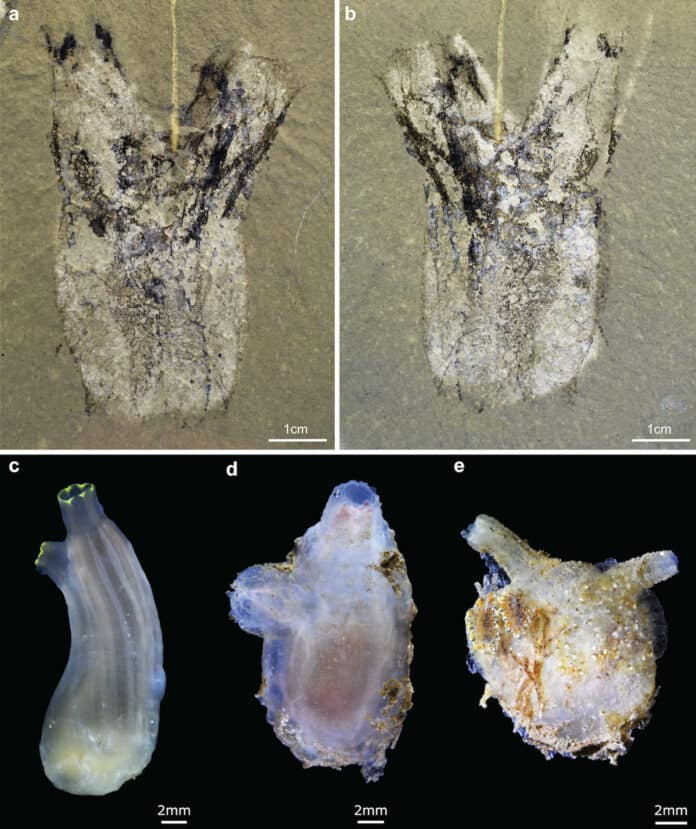Around 3000 marine invertebrates known as tunicates, known as urochordates, have a cellulosic extracellular matrix covering their bodies. They are related to vertebrates and are members of the subphylum Chordata. Their deep-time origins are complicated by the discrepancy in their morphology and life histories.
Harvard University postdoctoral researcher Karma Nanglu has found a 500-million-year-old fossil of a marine invertebrate belonging to the tunicates group.
Nanglu, a postdoctoral researcher in the Department of Organismic and Evolutionary Biology at Harvard University, said, “This animal is as exciting a discovery as some of the stuff I found when hanging off a cliffside of a mountain or jumping out of a helicopter. It’s just as cool.”
The newly discovered fossil, Megasiphon thylakos shows that prehistoric tunicates evolved from tadpole-like larvae to immobile, filter-feeding adults. Tunicates are bizarre creatures of various sizes and shapes and lead a very odd lifestyle. The basic morphology of an adult tunicate is typically barrel-shaped, with two siphons extending from its body.
One of the siphons uses suction to extract water containing food particles, which the animal can then filter via an internal basket-like mechanism to feed on. The other siphon releases the water once the animal has eaten.
There are two main tunicate lineages, ascidiaceans (often called “sea squirts”) and appendicularias. Most ascidiaceans begin their lives looking like a tadpole and mobile, then metamorph into a barrel-shaped adults with two siphons. They live their adult life attached to the seafloor. In contrast, appendicularians retain the look of a tadpole as they grow into adults and swim freely in the upper waters.
He said, “This idea that they begin as tadpole-looking larva that, when ready to develop, basically headbutts a rock, sticks to it, and begins to metamorphosis by reabsorbing its tail to transform into this being with two siphons is just awe-inspiring.”
The closest relatives of vertebrates, such as fish, animals, and even humans, are tunicates. Tunicates are mostly absent from the fossil record, with only a few fossils convincingly representing the group, making their study essential to understanding our evolutionary history.
Scientists used what could be gained from contemporary tunicate species to research tunicates. Due to the scarcity of fossils, research mostly focused on what might be inferred from current tunicate species.
Scientists could only think that the last common ancestor of the tunicates was either a benthic animal with two siphons, like the ascidiaceans, or a free-swimming animal, like the appendicularians, because no one knew the morphology and ecology of the tunicates.
High-resolution photos of M. thylakos allowed researchers to compare it to a modern ascidiacean. The parallels between Ciona’s muscles, which allow the tunicate to open and close its siphons, and the black bands in the 500-million-year-old fossil were striking.
The anatomy of the Megasiphon shows that tunicates’ evolutionary lifestyle included a non-moving adult that filters fed with its huge siphons. It’s quite rare to come across a tunicate fossil that not only provides a unique and unprecedented look into the early evolutionary history of this mysterious group.
M. thylakos is the only definitive tunicate fossil identified so far exhibiting soft tissue preservation. It is the oldest, originating in Utah’s middle Cambrian Marjum Formation. The Marjum Formation fossils originate just after the Cambrian Explosion, one of Earth’s most dramatic evolutionary events. Despite being diverse and numerous in current oceans, tunicates are strikingly absent from Cambrian rocks.
According to molecular clock calculations, ascidiaceans first appeared 450 million years ago. M. thylakos, on the other hand, at 500 million years old, provides the clearest look into the anatomy of ancient tunicates and their earliest evolutionary history. Significantly, M. thylakos demonstrates that most contemporary tunicate body design was already set shortly after the Cambrian Explosion.
Ortega-Hernández said, “The fossil immediately caught our attention,” “Although we mostly work on Cambrian arthropods, such as trilobites and their soft-bodied relatives, the close morphological similarity of Megasiphon with modern tunicates was simply too striking to overlook, and we immediately knew that the fossil would have an interesting story to tell.”
Researchers can say quite a deal about the evolutionary history of the tunicates because of the excellent quality of preservation and the age of the fossil, as they had almost no clear evidence for the ancestors’ life forms before this discovery. The geologists believe the Marjum Formation has just begun to reveal its secrets after gathering hundreds of new fossils this spring.
Journal Reference:
- Nanglu, K., Lerosey-Aubril, R., Weaver, J.C. et al. A mid-Cambrian tunicate and the deep origin of the ascidiacean body plan. Nature Communications. DOI: 10.1038/s41467-023-39012-4
